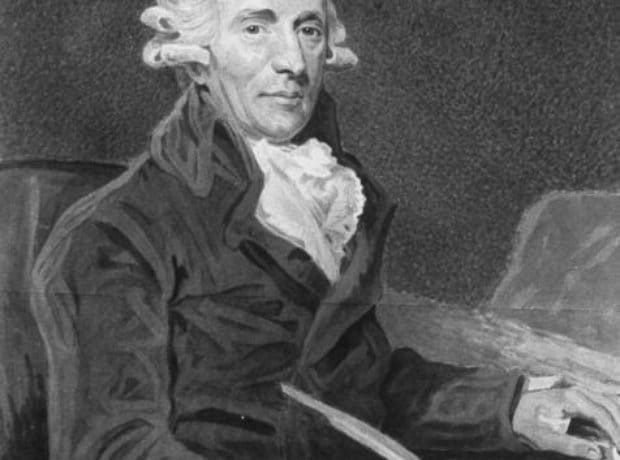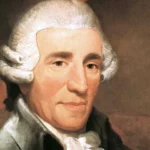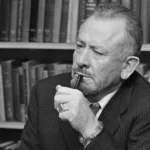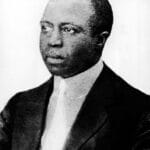Hey there, music lovers! Get ready to meet Joseph Haydn, a musical genius who made a big splash in the classical world. From his early days as a mischievous choirboy to his rise as a superstar composer, Haydn’s life is filled with unexpected twists and turns. Did you know he got kicked out of the choir for being a little naughty? Or that he spent years working for a noble family, cranking out symphonies and operas that would change music history forever? Let’s dive in and discover the fascinating story behind this incredible composer.
Interesting Facts About Joseph Haydn
Ever heard of Joseph Haydn? He’s kind of a big deal in the music world, often called the “Father of the Symphony.” But what’s really fascinating are the stories and quirks that made him such a unique figure. Let’s dive into some interesting facts about this musical genius.
- A Musical Prodigy from the Start: Imagine a five-year-old with a voice so angelic, he’s chosen to sing in the choir of St. Stephen’s Cathedral in Vienna. That was Haydn! Music was clearly in his blood from a very young age.
- The Symphony Master: Before Haydn came along, the symphony was a pretty basic musical form. But he saw its potential and transformed it into something truly grand. He wrote over 100 symphonies, each one a masterpiece that pushed the boundaries of what this musical form could be.
- A Dash of Humor in the Music: Haydn wasn’t all seriousness though. He had a playful side, and it often shone through in his music. For example, his Symphony No. 94, nicknamed “The Surprise,” features a sudden, loud blast of instruments that must have startled audiences back in the day!
- Always Innovating: Haydn wasn’t afraid to break the mold. He loved experimenting with different musical ideas. He wove elements of folk music into his compositions, bringing a fresh and exciting sound to the classical world. It’s this willingness to try new things that helped shape the future of classical music.
- Mozart’s Mentor: Here’s a fun fact: Haydn was a mentor to another musical legend – Wolfgang Amadeus Mozart! Imagine the musical wisdom Haydn must have shared. This mentorship is a testament to Haydn’s generosity and his impact on future generations of composers.
- A Man of the World: Haydn loved to travel. He spent two years in England, charming audiences with his music. These journeys undoubtedly broadened his musical horizons and exposed him to new ideas and influences.
- The Prolific Composer: Haydn’s musical output was simply astonishing. He composed over 1,000 pieces throughout his life – symphonies, concertos, chamber music, operas – you name it, he probably wrote it! This incredible body of work showcases his incredible talent and unwavering dedication to his craft.
- Bridging Musical Eras: Haydn’s career spanned a fascinating period in music history. He seamlessly blended the grandeur of the Baroque era with the elegance of the emerging Classical period. Think of him as a musical bridge connecting different styles and shaping the sound of music to come.
- A Lasting Musical Legacy: Haydn’s influence didn’t end with his lifetime. His innovations in the symphony, the string quartet, and other genres continue to inspire composers today. His music is still performed and enjoyed by audiences worldwide, a testament to the timelessness of his genius.
What Happened to Haydn at 16?
At the tender age of 16, Haydn experienced a life-altering event that would forever shape his musical journey. Imagine a young Joseph Haydn, his world revolving around music, his angelic voice soaring through the prestigious choir at St. Stephen’s Cathedral in Vienna. Life seemed idyllic until puberty hit.
As with many teenagers, Haydn’s voice underwent a dramatic transformation. It cracked, wobbled, and lost its choir-worthy quality. Getting kicked out of such a prestigious choir meant losing his position, his musical home, and likely a great deal of stability. It was a tough break for the young musician.
However, instead of succumbing to despair, Haydn saw this setback as an opportunity. He could have easily turned his back on music, but something within him refused to give up. Instead, he shifted his focus to composition, immersing himself in the intricacies of creating music. Countless hours were likely spent studying, experimenting, and pouring his heart and soul into his work.
This forced change in direction proved to be a pivotal moment in music history. Haydn’s dedication to composition led him to become one of the most celebrated composers of all time. He revolutionized the symphony, composed countless string quartets and concertos, and left an indelible mark on the world of music.
Looking back, it’s tempting to view this voice change as a blessing in disguise. While it’s impossible to know for certain what kind of musician Haydn would have become had he remained in the choir, his story serves as a testament to the power of resilience.
Haydn’s journey reminds us that setbacks can sometimes lead to extraordinary outcomes. His story encourages us to embrace challenges as detours that can lead to unexpected destinations. Perhaps there’s a budding composer out there, navigating their own voice change, who will find inspiration in Haydn’s ability to transform a setback into a triumph.
What is Joseph Haydn Most Famous For?
Haydn’s impact on music is undeniable. He didn’t just compose pretty tunes; he pushed boundaries, established new norms, and inspired generations of musicians. Here’s a glimpse into his most notable achievements:
- Father of the Symphony: Imagine a world without symphonies as we know them today. Haydn didn’t invent the symphony, but he revolutionized it, defining its structure and shaping the symphony we hear today. His contributions earned him the title “Father of the Symphony.”
- Master of Genres: Haydn’s versatility as a composer is evident in his vast repertoire. He composed concertos that highlighted solo instruments, operas that told stories through music, and choral works that showcased the power of the human voice.
- The Mentor: Haydn’s influence extended beyond his own compositions. He mentored young Mozart and Beethoven, guiding their careers and shaping their musical development. This mentorship highlights Haydn’s generosity and the lasting impact he had on future generations of composers.
Haydn’s legacy as one of the most important figures in Western music history is a testament to his ability to innovate, inspire, and leave an enduring mark on the world of music.
Did Joseph Haydn Have a Wife?
Haydn’s personal life was marked by both love and disappointment. He harbored deep affection for Therese Keller, but fate had other plans. Therese’s decision to become a nun left Haydn heartbroken. He eventually married her sister, Maria Anna, but their marriage proved to be an unhappy one.
Maria Anna showed little interest in music, a poignant irony considering her husband’s profession. The couple never had children, adding another layer of complexity to their relationship. Some historians suggest that Haydn may have had a romantic relationship with the Italian mezzo-soprano Luigia Polzelli, who sang in the Esterházy opera company, where he worked for many years. However, concrete evidence to support this claim remains elusive.
Despite the turbulence in his personal life, Haydn’s passion for music never wavered. He channeled his emotions and experiences into his compositions, creating timeless masterpieces that continue to resonate with audiences centuries later.
What Was Haydn Like as a Person?
Historical accounts suggest that Haydn possessed a warm and engaging personality. Despite facing challenges early in his life, he maintained a positive outlook and a playful sense of humor. He was known for his cheerful disposition and his ability to find amusement in everyday situations.
Beyond his jovial nature, Haydn was also highly regarded for his diplomacy and interpersonal skills. He navigated the complexities of aristocratic patronage with grace and empathy. His ability to connect with people from all walks of life contributed to his success as a composer and a respected figure in society.
While our understanding of historical figures is always evolving, the glimpses we have into Haydn’s character suggest he was a man of many dimensions – talented, resilient, and undeniably human.
Areas of ongoing research:
- Historians continue to explore Haydn’s personal letters and documents for deeper insights into his thoughts, relationships, and personal experiences.
- Research into the social dynamics of the Classical era sheds further light on the context of Haydn’s life and personality.
What is a Fun Fact About Haydn?
Haydn’s impact on music earned him the affectionate nickname “Papa Haydn,” a testament to the respect and admiration he received from fellow musicians. He was seen as a father figure in the musical world, guiding and influencing countless aspiring artists.
Among his many notable achievements, Haydn’s prolific output of symphonies, over 100 in total, solidified his reputation as the “Father of the Symphony.” His symphonies were not merely formulaic compositions; they were infused with his playful personality and innovative spirit. His most famous symphony, Symphony No. 94, nicknamed the “Surprise Symphony”, features a sudden, loud chord in the second movement, startling audiences and showcasing Haydn’s ability to surprise and delight.
Which Composers Died at the Age of 35?
While Haydn enjoyed a long and illustrious career, some composers met an untimely end at the age of 35. These individuals left behind a legacy cut short, leaving the world to wonder what they might have accomplished with more time.
- Wolfgang Amadeus Mozart: Perhaps the most famous example, Mozart’s death at 35 robbed the world of one of its greatest musical geniuses.
- Franz Schubert: Known for his Lieder (art songs) and chamber music, Schubert’s early death silenced a unique voice in Romantic music.
- Georges Bizet: Best known for his opera “Carmen,” Bizet’s premature passing cut short a promising career.
- Henry Purcell: A prominent English composer of the Baroque era, Purcell’s death at 36 remains a significant loss to the world of music.
The early deaths of these composers highlight the fragility of life and the enduring power of their artistic contributions.
What Did Haydn Do Before He Died?
Haydn’s final years were marked by a mixture of creative output, mentorship, and declining health. Despite physical ailments, his passion for music never waned.
- Monumental Oratorios: Haydn completed two of his most celebrated works, the oratorios “The Creation” and “The Seasons,” in his later years. These grand compositions showcased his mastery of choral music and his ability to convey epic narratives through sound.
- Final Symphony: Haydn’s last symphony, Symphony No. 104, nicknamed the “London” Symphony, served as a fitting tribute to the city that had embraced him. This symphony, full of vitality and grandeur, reflected the profound impact London had on his life and career.
- Mentoring Beethoven: Even as his health deteriorated, Haydn continued to share his knowledge and experience. He mentored a young Ludwig van Beethoven, recognizing the immense talent of the future composer.
Haydn’s final years were a testament to his enduring creativity and his dedication to nurturing the next generation of musical talent. Even as he faced his own mortality, his spirit remained undimmed.
What Happened to Haydn’s Head After His Death?
Haydn’s posthumous journey took a rather bizarre turn due to the practices of phrenology, a pseudoscience popular in the 19th century. Phrenologists believed that the shape of a person’s skull could reveal their character and intellectual abilities. They were particularly interested in studying the skulls of accomplished individuals, believing they held the key to understanding genius.
Ten years after Haydn’s death, a group of phrenologists, eager to examine the skull of a musical virtuoso, stole Haydn’s skull from his tomb! To cover up their crime, they replaced it with another skull. It wasn’t until 1954 that Haydn’s real skull was recovered and returned to his tomb.
Ironically, the phrenologists likely believed they had struck gold when they examined Haydn’s skull. It had a noticeable bump in the area they associated with musical talent, seemingly confirming their theories. However, phrenology has since been debunked as a legitimate science.
In a final twist, when Haydn’s skull was returned to his tomb, the fake skull was left in place. As a result, Haydn’s final resting place now houses two skulls – a strange and somewhat eerie footnote to the life of a musical icon.
Why Was Haydn Kicked Out of the Church Choir?
As a young choirboy at St. Stephen’s Cathedral, Haydn had a mischievous streak that, combined with a natural biological process, led to his dismissal from the choir.
Historical accounts suggest that Haydn’s pranks and antics often crossed the line. One particular incident involved Haydn snipping off the pigtail of a fellow choirboy. While it’s unclear if this specific prank was the final straw, it highlights Haydn’s mischievous nature.
However, pranks weren’t the sole reason for Haydn’s departure. Like many boys his age, he began to undergo puberty, and his voice began to change. This natural process made it difficult for him to maintain the high notes required of a choirboy.
While being dismissed from the choir might have seemed like a setback at the time, it ultimately set Haydn on a path to greatness. It forced him to seek out new musical opportunities, hone his skills independently, and develop a resilient spirit that would serve him well throughout his career.
What Happened During Haydn’s Surprise Symphony?
Haydn’s Symphony No. 94, affectionately nicknamed the “Surprise Symphony,” earned its moniker from a single, unexpected event during its performance. As the orchestra gracefully navigated the peaceful and serene melody of the second movement, known as the Andante movement, a sudden shift in dynamics jolted the audience.
Out of nowhere, a powerful G major chord erupted from the orchestra. This “surprise” chord, played with the full force of the ensemble, created a stark contrast to the preceding tranquility. Trumpets blared, timpani boomed, and the string section played with unrestrained gusto.
The sudden shift from tranquility to a sonic outburst would have startled those in attendance. Some theories suggest that Haydn intended this unexpected chord to awaken anyone who may have dozed off during the quieter passages.
Regardless of his intentions, the “surprise” chord became a defining feature of the symphony, cementing its place as a beloved and enduring masterpiece. It stands as a testament to Haydn’s ability to innovate, engage his audience, and infuse his music with a touch of playful surprise.
There are many unknown interesting facts about Padre Pio. Did you know that he could bilocate, levitate, and even heal people at a distance? He was also a true mystic, who had many visions of Jesus and Mary. His life is a testament to the power of faith, and his story continues to inspire people today. And what about the interesting facts about St. Philomena? She was a young martyr who was brutally tortured and killed for her faith. Her body was miraculously preserved, and it is said that she has performed many miracles since her death. Her story is a reminder that even in the face of adversity, we can find strength and hope.

















2 thoughts on “Interesting Facts About Joseph Haydn”
Comments are closed.